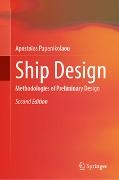En savoir plus
This book explores the foundations of ship design, focusing on methodologies for the preliminary design of ships. It includes a comprehensive bibliography on ship design and several appendices featuring useful charts for selecting the main dimensions and other basic characteristics of various types and sizes of ships (Appendix A). Additionally, it covers the determination of hull form using systematic hull form series data (Appendix B), a detailed explanation of the relational method for preliminary ship weight estimation (Appendix C), a concise review of the historical evolution of shipbuilding science and technology from the prehistoric era to the present (Appendix D), and a historical overview of regulatory developments in ship damage stability (Appendix E).
The present second edition incorporates more recent scientific, technological, and regulatory advancements in ship design and maritime transport. It specifically addresses the introduction of holistic approaches and optimization in ship design, as well as the impact of the latest international regulations concerning the decarbonization of shipping. This edition also includes two additional appendices: the holistic optimisation of ship design with an innovative tanker design case study (Appendix F) and a multi-authored State of the Art report of ship design in the era of digital transition (Appendix G).
This book serves as a textbook for ship design courses and as supplementary reading for university and college students in naval architecture and related disciplines. It also functions as a reference for naval architects, practicing engineers in related fields, and ship officers seeking a systematic introduction to the broader field of ship design or practical methodologies for estimating ship dimensions, properties, and design elements.
Table des matières
1 General on Ship Design.- 2 Selection of Main Dimensions and Calculation of Basic Ship Design Values.- 3 Ship’s Hull Form.- 4 Naval Architectural Drawings and Plans.- 5 Machinery Installation, Propulsion and Steering Devices.- 6 Estimation of Building Cost.- Appendix A: Diagrams of Regression Analysis of Basic Design Values for Merchant Ships.- Appendix B: Systematic Hull Form - Model Series.- Appendix C: Determination of Ship’s Displacement with the Relational Method of Normand.- Appendix D: Historical Evolution of Shipbuilding.- Appendix E: Subdivision and Damage Stability of Ships - Historical Developments and the Way Ahead.
A propos de l'auteur
Prof. Dr. -Ing. Habil. Apostolos D. Papanikolaou is em. Professor of the National Technical University of Athens. He studied Naval Architecture and Marine Engineering at the Technical University of Berlin. He headed more than 80 funded research projects and was author/co-author of over 700 scientific publications dealing with the design and optimization of conventional and unconventional vessels, the hydrodynamics analysis of ships in calm water and in seaways, the logistics-based ship design, the stability and safety of ships and regulatory developments regarding maritime safety and decarbonisation of shipping at IMO. He received various international prize awards for his research work, among them the RINA Safer Ship award in 1999, the Lloyds List 2009 Greek Shipping award on Technical Innovation, the prestigious Dr. K. Davidson medal/award of SNAME for outstanding achievement in ship research in 2010. He is also the winner of the European Champions Award for Senior Researchers in Waterborne Transport in 2014 and 2024. He is Fellow and former International Vice-President of the Soc. of Naval Architects and Marine Engineers - SNAME (USA), Fellow of the Royal Institution of Naval Architects -RINA (UK) and the Schiffbautechnische Gesellschaft-STG (Germany) and Distinguished Foreign Fellow of the Japanese Soc. of Naval Architects and Ocean Engineers - JASNAOE (Japan).

